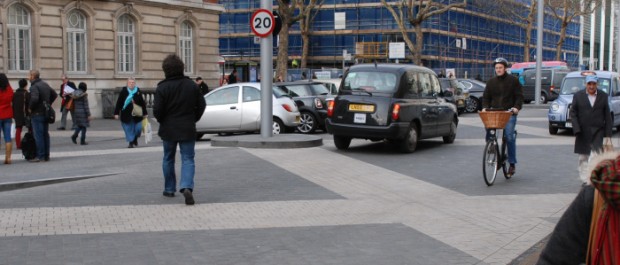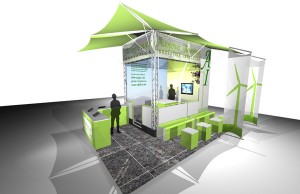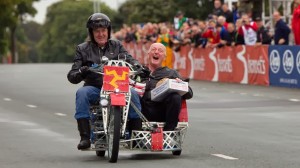We need rules for the road – don’t we? Rules control traffic for our safety, they prioritise usage for efficiency and they segregate users for our protection. Rules are manifest in the road: we see them in cycle lanes, bus lanes, pavements, kerbs, bollards, railings and barriers. But would the roads be safer if we took away the rules?
The bridge was instrumental in promoting TFL’s cycle hire scheme and its Cycle Superhighway (see stand design and interactives). So it was with great interest that I learned that Exhibition Road, in London, had recently been rebuilt, based on a ‘shared-use’ concept.
Many of the debates around cycle – and road – safety hinge on the issue at the heart of this new scheme. The theory goes that the more you segregate individual road users, the less aware they become. Further, speed increases due to an increased sense of security and right of passage. The ‘shared-use’ concept – pioneered by a Dutch engineer and adopted in many places in Europe – assumes all road users – especially drivers – are inherently considerate and will negotiate with other road users when the strictures of rules are removed. It seems that when no one rules the road – all road users becomes more aware and responsible – and therefore safer. Key to the concept of ‘shared-use’ is the ability to see and fully engage with the public area. As a local experiment shows – when barriers and clutter in Kensington High Street were removed – there was a 60% reduction in pedestrian accidents.
My first impression of Exhibition Road was of cyclists pedalling with freedom and assurance, pedestrians happily wandering about and traffic moving in a calm and respectful manner. So the concept would appear to be working.
However, beyond the benefits of improved usage – and one hopes safety – this architecturally-designed scheme has resulted in a very beautiful and open public space. No longer a dour, uninviting thoroughfare – it has become an elegant, restful, and pleasant place to be. The inspired folk at The Royal Borough of Kensington and Chelsea have put the civilisation back into a civic space. Even the area around South Kensington station feels more like a continental piazza, lined with cafes, bars and restaurants. I have no doubt it will increase the area’s popularity and become a new and trendy place to congregate. Indeed, the recently-formed multi-foundation arts and science organisation: ‘Exhibition Road’ – can now, genuinely and proudly, promote itself as the cultural heartland of London – the ultimate destination for anyone with a thirst for discovery and creativity.
I have had some comments about the safety of such schemes for disabled, blind and hard of hearing. Indeed the architech’s plans were delayed through adaptations to the plan to address these issues. The only reference I can find – and see – are ridges in the granite surface to help define a pavement area for the blind. Alas the purity of the scheme is compromised by the diversity of use.
I have observed other compromises. On two visits I noticed that traffic does not automatically shift into angelic mode on entering the zone. At the top of the road the clear, barrier-less layout has unwittingly allowed drivers an easy way to use the road for ‘U-turns’ – naturally such intentions in drivers increase speed, distracts concentration and ultimately makes the scheme less safe. This must be extremely disheartening for the planners and designers to witness. It goes against the grain of the concept to put up no U-turns signs – so there is nothing that can be done except to sit back and hope that drivers realise that U-turns on this road is anti-social behaviour. Feels like there needs to be more work done on the psychology of drivers.
At the other end I have seen many taxi drivers use their horns in a frustrated manner attempting to influence pedestrian behaviour. I suspect the road is – and always has been a kind of cut-through from Cromwell Rd to Kensington Gardens and as such the intentions of the scheme will be counter-intuitive for drivers in a hurry. I do sense a kind of pedestrian power presence at this end of the road – or perhaps even a confusion over the degree of pedestrianisation. I have heard of one anecdotal story of pedestrians nearly being run down by speeding – or irritated – traffic.
Perhaps it is too much to believe that road users living in world of road-rage – get there quick – and get away with what you can, irrespective of other people, will change their ways. Perhaps we get the rules we deserve.
It would be a shame to build back the solid strictures of enforcmed decent behaviour. The right way to think is to expect and trust people to behave in a considerate way to each other. I hope this scheme will prove that this is a reasonable aim.



